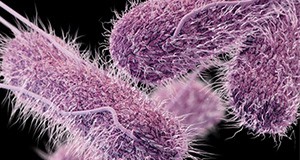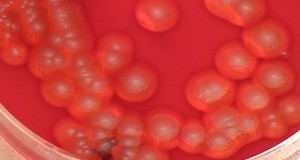Ingesting foods contaminated with Bacillus cereus bacteria can lead to nausea, vomiting, abdominal cramps, and diarrhea. Though B. cereus is commonly found in many types of fresh and processed foods, proper cooking, handling, and storage can minimize the risk of contamination. This 5-page fact sheet explains how B. cereus is transmitted, what foods it is commonly associated with, the methods used to prevent contamination, and good practices for receiving, handling, processing, and storing food. Written by Keith R. Schneider, Renée Goodrich Schneider, Rachael Silverberg, Ploy Kurdmongkoltham, and Bruna Bertoldi, and published by the Department of Food Science and Human Nutrition.
http://edis.ifas.ufl.edu/fs269
Tag: Rachael Silverberg
Preventing Foodborne Illness: Typhoid Fever: Salmonella Typhi

Typhoid fever is a blood infection caused by the consumption of food or water contaminated with the bacterium Salmonella enterica.Typhoid fever is easily controlled and relatively uncommon in the United States, but an estimated 21.5 million people per year are affected by typhoid fever in developing nations including regions in Asia, Africa, and South America. Many of the cases of typhoid fever in the United States are acquired through international travel to these regions. This four-page fact sheet explains the causes and symptoms of typhoid fever, as well as describing who is at risk, what foods have commonly been associated with typhoid fever, and how to implement certain sanitation methods to prevent the spread of typhoid fever. Written by Keith R. Schneider, Renée Goodrich Schneider, and Rachael Silverberg, and published by the Food Science and Human Nutrition Department.
http://edis.ifas.ufl.edu/fs125
Preventing Foodborne Illness: Campylobacteriosis

Campylobacteriosis is a gastrointestinal infection caused by bacteria of the genus Campylobacter. These bacteria require low levels of oxygen to survive and have been found in wild birds, poultry, pigs, cattle, domesticated animals, unpasteurized milk, produce, and contaminated water. A part of a series on preventing foodborne illness, this five-page fact sheet describes the Campylobacter bacteria, the causes and symptoms of campylobacteriosis disease, and how to prevent the disease through good sanitation methods and practices for receiving, handling, processing, and storing food products. Written by Soohyoun Ahn, Renée M. Goodrich-Schneider, Rachael Silverberg, and Keith R. Schneider, and published by the Food Science and Human Nutrition Department.
http://edis.ifas.ufl.edu/fs098
The Cost of Food Safety
 This new publication discusses the costs and long-term benefits associated with the implementation of food safety programs. This 5-page fact sheet covers the history of HACCP, costs associated with the application of food safety programs, reasons to improve food safety, and the financial impact of foodborne illnesses. Written by Annelys Hessing, Renée Goodrich Schneider, Alan Gutierrez, Rachael Silverberg, Michael S. Gutter, and Keith R. Schneider, and published by the UF Department of Food Science and Human Nutrition, October 2015.
This new publication discusses the costs and long-term benefits associated with the implementation of food safety programs. This 5-page fact sheet covers the history of HACCP, costs associated with the application of food safety programs, reasons to improve food safety, and the financial impact of foodborne illnesses. Written by Annelys Hessing, Renée Goodrich Schneider, Alan Gutierrez, Rachael Silverberg, Michael S. Gutter, and Keith R. Schneider, and published by the UF Department of Food Science and Human Nutrition, October 2015.
http://edis.ifas.ufl.edu/fs270
Food Safety within the Household: Risk Reduction

Food poisoning is common in the United States. The CDC estimates that 48 million Americans acquire foodborne illness every year, many of which were attributed to food preparation occurring in private homes. In 2013, the top five identified bacterial and viral causes of food poisoning attributed to home food preparation were Salmonella, norovirus, shiga-toxin-producing Escherichia coli, Clostridium perfringens, and Campylobacter. This six page fact sheet outlines the most common food-safety handling mistakes, which are improper food storage, inadequate cooking or reheating temperatures, cross-contamination, and infected food handlers. Written by Lucianna Grasso, Rachael Silverberg, George L. Baker, Renée M. Goodrich-Schneider, and Keith R. Schneider, and published by the Food Science and Human Nutrition Department.
http://edis.ifas.ufl.edu/fs195
Preventing Foodborne Illness: Bacillus cereus

Ingesting foods contaminated with Bacillus cereus bacteria can lead to nausea, vomiting, abdominal cramps, and diarrhea. Though B. cereus is commonly found in many types of fresh and processed foods, proper cooking, handling, and storage can minimize the risk of contamination. This 5-page fact sheet explains how B. cereus is transmitted, what foods it is commonly associated with, the methods used to prevent contamination, and good practices for receiving, handling, processing, and storing food. Written by Keith R. Schneider, Renée Goodrich Schneider, and Rachael Silverberg, and published by the UF Department of Food Science and Human Nutrition, August 2015.
http://edis.ifas.ufl.edu/fs269
Preventing Foodborne Illness: Norovirus

If you have ever had the stomach flu, norovirus was likely the culprit. Norovirus is the most common cause of foodborne illness in the United States and is transmitted through direct person-to-person contact or contaminated objects and food. This 5-page fact sheet covers how norovirus is spread, foods associated with norovirus, symptoms of infection, who is at risk, as well proper sanitation methods for preventing the spread of norovirus. Written by Rachael Silverberg, Melissa K. Jones, Renée Goodrich Schneider, Aswathy Sreedharan and Keith R. Schneider, and published by the UF Food Science and Human Nutrition Department, June 2015.
http://edis.ifas.ufl.edu/fs129
Preventing Foodborne Illness: Cyclospora cayetanensis
 Cyclospora cayetanensis is a microscopic, spore-forming, intestinal protozoan parasite and a known cause of the gastrointestinal infection cyclosporiasis, often referred to as “traveler’s diarrhea” for its prevalence among visitors to regions where the species is endemic. These organisms have a protective covering that makes them resistant to disinfectants and that gives Cyclospora the ability to survive outside of hosts for extended periods. The incidence of cyclosporiasis has been increasing worldwide, with several documented cases in the United States and Canada. This 4-page fact sheet was written by Keith R. Schneider, Rachael Silverberg, Susie Richardson, and Renée Goodrich Schneider, and published by the UF Department of Food Science and Human Nutrition, March 2015. (Photo: CDC/DPDx – Melanie Moser)
Cyclospora cayetanensis is a microscopic, spore-forming, intestinal protozoan parasite and a known cause of the gastrointestinal infection cyclosporiasis, often referred to as “traveler’s diarrhea” for its prevalence among visitors to regions where the species is endemic. These organisms have a protective covering that makes them resistant to disinfectants and that gives Cyclospora the ability to survive outside of hosts for extended periods. The incidence of cyclosporiasis has been increasing worldwide, with several documented cases in the United States and Canada. This 4-page fact sheet was written by Keith R. Schneider, Rachael Silverberg, Susie Richardson, and Renée Goodrich Schneider, and published by the UF Department of Food Science and Human Nutrition, March 2015. (Photo: CDC/DPDx – Melanie Moser)
http://edis.ifas.ufl.edu/fs130
Preventing Foodborne Illness: Clostridium botulinum
 Clostridium botulinum is ubiquitous in nature, often found in soil and water. The bacteria and spores alone do not cause disease, but they produce the botulinum toxin that causes botulism, a serious paralytic condition that can lead to death. Although it is one of the least common of the foodborne diseases, anyone is susceptible even with the ingestion of only a small amount of toxin present in contaminated food. Immunocompromised individuals, young children, and elderly individuals may suffer from more serious symptoms. This 6-page fact sheet was written by Keith R. Schneider, Rachael Silverberg, Alexandra Chang and Renée Goodrich Schneider, and published by the UF Department of Food Science and Human Nutrition, December 2014.
Clostridium botulinum is ubiquitous in nature, often found in soil and water. The bacteria and spores alone do not cause disease, but they produce the botulinum toxin that causes botulism, a serious paralytic condition that can lead to death. Although it is one of the least common of the foodborne diseases, anyone is susceptible even with the ingestion of only a small amount of toxin present in contaminated food. Immunocompromised individuals, young children, and elderly individuals may suffer from more serious symptoms. This 6-page fact sheet was written by Keith R. Schneider, Rachael Silverberg, Alexandra Chang and Renée Goodrich Schneider, and published by the UF Department of Food Science and Human Nutrition, December 2014.
http://edis.ifas.ufl.edu/fs104